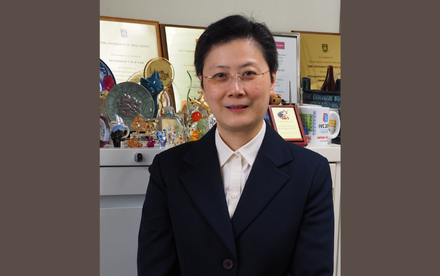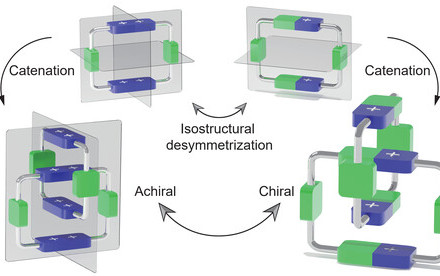12 Oct 2020
HKU scientists and microbiologists jointly discover a novel antiviral strategy for treatment of COVID-19 using existing metallodrugs
Key members of the research team. From the right: Dr Jasper F W CHAN, Dr Shuofeng YUAN, Professor Kwok-Yung YUEN, Professor Hongzhe SUN, Dr Runming WANG and Miss Suyu WANG.
A research team led by Professor Hongzhe SUN, Norman & Cecilia Yip Professor in Bioinorganic Chemistry, Department of Chemistry, Faculty of Science, and Professor Kwok Yung YUEN, Henry Fok Professor in Infectious Diseases, Department of Microbiology, Li Ka Shing Faculty of Medicine of the University of Hong Kong (HKU), has discovered a novel antiviral strategy for treatment of COVID-19.
They discover a class of metallodrugs currently used in the treatment of other infectious diseases is showing efficacy to potently suppress SARS-CoV-2 replication and relieve viral-associated symptoms in an animal model.
The findings provide a new and readily available therapeutic option with high clinical potential for infection with SARS-CoV-2. This ground-breaking work has been published online in a top-class scientific journal Nature Microbiology. A related patent has been filed in the US.
Background
SARS-CoV-2 is an emerging coronavirus that has caused globally over 30 million laboratory-confirmed cases of COVID-19 including more than 1 million deaths since December 2019. While vaccine is still not available, the discovery and development of virus-specific antiviral drug could be one approach to treat or prevent infection caused by this novel coronavirus. Given the urgency and severity of the global pandemic, repurposing currently available drugs is the most practical route for the rapid identification of anti-COVID-19 agent. Remdesivir, a broad-spectrum antiviral drug, has been reported to show efficacy against SARS-CoV-2. However, the drug’s global shortage, relatively high price and lack of significant clinical benefits in patients with severe COVID-19 have so far limited its widespread use. Other ongoing clinical trials on a series of antiviral agents are demonstrating the big challenge to improve the clinical outcomes of patients. Therefore, more intense efforts are urgently needed to evaluate a wider spectrum of clinically approved drugs by alternative strategies.
Study method and findings
Historically, metal compounds have found use as anti-microbial agents, but their antiviral activities have rarely been explored. Their new findings identify ranitidine bismuth citrate (RBC), a commonly used anti-ulcer drug for the treatment of Helicobacter pylori-associated infection, through a primary screening over a set of metallodrugs and related compounds, as a potent anti-SARS-CoV-2 agent, both in vitro and in vivo. Targeting the vital non-structural protein 13 (Nsp13), a viral helicase for SARS-CoV-2 replication, RBC demonstrated its ability to potently suppress the activity of SARS-CoV-2 helicase through kicking out the crucial zinc(II) ions in its zinc-binding domain via a distinct metal displacement route. RBC exhibited low cytotoxicity and reduced the viral loads in SARS-CoV-2-infected cells by over 1,000-folds, with a high selectivity index of 975, which indicates the window between cytotoxicity and antiviral activity is remarkably wide. In comparison, the selectivity index of remdesivir, a currently used antiviral agent candidate for treating COVID-19 infections, amounts to 129.
Importantly, RBC suppressed SARS-CoV-2 replication, with decreased viral loads by ~100 folds in both upper and lower respiratory tracts, and mitigated virus-associated pneumonia in a golden Syrian hamster model.
Significantly, RBC remarkably diminished the level of prognostic markers for severe COVID-19, as well as other major pro-inflammatory cytokines and chemokines in the infected hamsters in comparison to either remdesivir-treated group or control group. Mechanism studies validated that SARS-CoV-2 helicase is one of the main targets of RBC. This drug irreversibly kicked out the crucial zinc(II) ions in the zinc-binding domain of SARS-CoV-2 helicase and formed the bismuth-bound SARS-CoV-2 helicase via a distinct metal displacement route. RBC and its related Bi(III) compounds dysfuntionalized SARS-CoV-2 helicase through the potent inhibition towards both the ATPase (IC50=0.69 µM) and DNA-unwinding (IC50=0.70 µM) activities of this enzyme.
Their findings highlight viral helicase could serve as a druggable target and the clinical potential of bismuth(III) drugs or other metallodrugs for the treatment of SARS-CoV-2 infection. By validating the results of targeting viral helicase, more antiviral agents could be designed and discovered, since this protein is rarely selected as a drug target previously. In the future, combinatorial (‘cocktail’) regimens consisting of clinically approved drugs that are readily available and have exhibited anti-SARS-CoV-2 activity, such as the combination of RBC, dexamethasone and interferon-β1b, may serve as a promising strategy for treating COVID-19 infection after a systemic evaluation in future studies.
This study provided potential metallodrug-based drugs for fighting the raging COVID-19 pandemic.
About the key member of the research team
Department of Chemistry, Faculty of Science
- Professor Hongzhe SUN, Norman & Cecilia Yip Professor in Bioinorganic Chemistry, Chair Professor of Chemistry
- Dr Runming WANG, Post-doctoral Fellow, Department of Chemistry
Department of Microbiology, Li Ka Shing Faculty of Medicine
- Professor Kwok-Yung YUEN, Henry Fok Professor in Infectious Diseases; also a Co-Director of the State Key Laboratory of Emerging Infectious Diseases and Academician of the Chinese Academy of Engineering
- Dr Shuofeng YUAN, Research Assistant Professor
- Dr Jasper F W CHAN, Clinical Assistant Professor
Staunch Supporters
The work was supported by Research Grants Council (RGC) of Hong Kong, the National Key R&D Programmes of China, the University of Hong Kong (HKU) Seed Fund for Basic Research and donations from the Lo Ying Shek Chi Wai Foundation, Richard Yu and Carol Yu, the Shaw Foundation of Hong Kong, Michael Seak-Kan Tong, May Tam Mak Mei Yin, Hong Kong Sanatorium & Hospital, Hui Ming, Hui Hoy and Chow Sin Lan Charity Fund Limited, Chan Yin Chuen Memorial Charitable Foundation, Marina Man-Wai Lee, the Hong Kong Hainan Commercial Association South China Microbiology Research Fund, the Jessie & George Ho Charitable Foundation, Perfect Shape Medical Limited, Kai Chong Tong, Foo Oi Foundation Limited, Tse Kam Ming Laurence, and Norman & Cecilia Yip Foundation.
Link of the article: https://www.nature.com/articles/s41564-020-00802-x
Image 1. (a) Inhibition of the double-stranded (ds) DNA unwinding activity of the SARS-CoV-2 helicase by RBC (b) The substitution of zinc(II) in SARS-CoV-2 helicase by bismuth(III). (c) Virus copies in the cell culture supernatant exposed to RBC treatment were determined at 48 hours post viral infection in Vero E6 cells (d-f) Hamsters were intranasally inoculated with 104 p.f.u. of SARS-CoV-2 and intraperitoneally given either DMSO (vehicle control), RBC or remdesivir. Respiratory tissue viral yields in the nasal turbinate and lung tissues of the hamsters were determined by (d) qRT–PCR assay and (e) median tissue culture infective dose (TCID50) assay, respectively. (f) Representative chemokine and cytokine assessment of the lung tissues (n = 3) of the indicated groups, as detected in the lung tissue homogenate. The results are shown as mean ± s.d. *P < 0.05, **P < 0.01 and ***P < 0.001 when compared with the DMSO group. NS, not significant. (g-j) Representative images of the viral N protein distribution in lung tissue sections from groups of uninfected hamsters (g) and infected hamsters treated with DMSO (h), remdesivir (i) and RBC (j), respectively.
Image 2. Proposed structure of Bi-bound zinc-bindnig domain of SARS-CoV-2 helicase. Through kicking out the crucial zinc(II) ions in the zinc-binding domain of SARS-CoV-2 helicase, RBC demonstrated its ability to potently suppress the replication of SARS-CoV-2.







